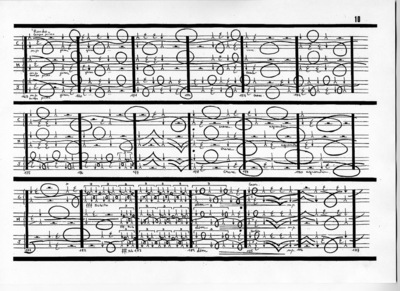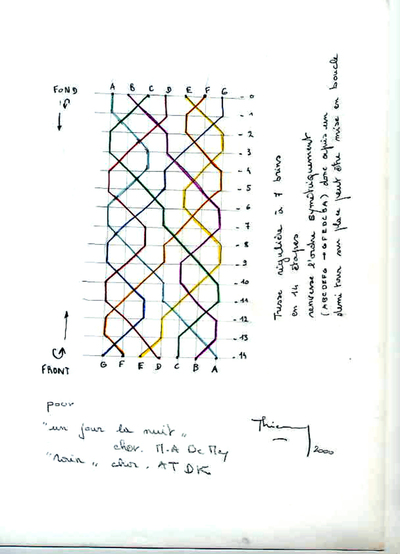Visuals Ax 1
00:00:12,163 00:00:52,241
Instructions and score for Musique de Tables (1987)
Illustrations from Thierry De Mey’s own work as a composer of gestural music. De Mey has invested much time and effort in creating notation systems to write down his compositions so that pieces like Hands, Musique de Tables, Silence Must Be, etc. can be transmitted to other composers. His system of writing makes use of a combination of analogical and symbolical notations.
Visuals Ax 2: Floor patterns and time structures for choreography
00:00:52,241 00:01:25
Tresses
Both Rain (2001) by Anne Teresa De Keersmaeker and Un Jour la Nuit by Michèle Anne De Mey are based on this floor pattern, which Thierry De Mey calls ‘tresses’. It illustrates how a floor pattern can be filled with movements by different choreographers. In Rain the underlying floor pattern is drawn on stage with tape, visible to the audience.
Fibonacci
The underlying floor pattern of Amor Constante is based on the Fibonacci spirals. Also the musical rhythm stems from the proportions in the Fibonacci numbers.
Audio quotes
Thierry De Mey explains that his work on scores can roughly be divided into two main axes. The first ax relates to his own work as a composer of gestural music, where he was confronted with the question of how to write down his compositions in order to transmit them to other composers or ensembles. The second ax is related to his collaborations with choreographers and with the ‘written documents’ (such as timelines, floor patterns, drawings) he has proposed as underlying structures or strategies for choreography.
In the second audio fragment Thierry De Mey elaborates on the second ax of his work. He asks how a written document (such as a floor pattern) can be a tool to create dance.



